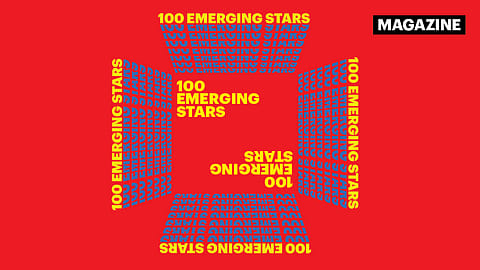100 Emerging Stars: Companies redefining success beyond the Fortune 500 universe
Fortune India’s maiden 100 Emerging Stars list.

This story belongs to the Fortune India Magazine May 2025 issue.
LIKE ALL THINGS countless, astronomers estimate that our own Milky Way is home to over 100 billion stars—each burning at its own intensity, some fading, others just beginning to shine. In many ways, the stock market mirrors this galactic sprawl: vast, dynamic, and teeming with potential stars.
Amid this financial Milky Way, Fortune India has turned its gaze towards a constellation of promise—a carefully curated galaxy of 100 emerging stars—a list of India’s most formidable rising enter prises—which are beyond the realm of the Fortune 500 India universe— ranked by one unshakeable metric: net sales. But entry into the list wasn’t based on size alone. Each company had to pass a series of stringent filters—sustained top-line growth, healthy profit generation, and capital-efficient operations. In short, this isn’t a flashy leaderboard.
Together, these 100 companies clocked a staggering ₹1,46,550 crore in cumulative revenues (FY24) across sectors, geographies, and business models. While the list’s scale is impressive, the profitability narra tive beneath it is equally compelling. The cumulative net profit of these 100 companies stands at ₹16,753 crore, translating to a healthy earnings base across a widely dispersed sectoral mix. At the top end of the revenue spectrum, names such as Ahluwalia Contracts, Garden Reach Shipbuilders, and Tata Elxsi dominate, combining operational efficiency with domain expertise. Goodluck India, Gravita, and Gabriel India add industrial heft, while Metro Brands and Hindustan Foods bring consumer facing flair.
From defence manufacturing to digital transformation, and from auto ancillaries to analytics, the breadth of the list speaks to the sheer horizontal growth of India Inc. Of the 100, 61 companies reported annual prof its exceeding ₹100 crore, with a combined revenue base of over ₹1.09 lakh crore. Even more striking, 22 of these companies alone account for ₹8,647 crore in net profits—more than half the cumulative profit pool—on combined sales of over ₹55,000 crore. In other words, profit of 15.72 paise per rupee of sales. An indication that these companies have not just figured out how to grow but grow profitably. Within the 100, a hand ful of companies stand out for combining high return on capital employed (RoCE) with healthy revenue and earnings com pounding, reinforcing the adage: it’s not just about growing fast—it’s about growing right.
Take Esab India, for instance. A capital goods firm that clocks a three year average RoCE of 62.87%, it has grown sales at 22.2% CAGR and prof its at 40.1% CAGR over the same period. That kind of performance in a B2B industrial setting speaks volumes about pricing power, product quality, and asset efficiency. Similarly, Shilchar Technologies, a lesser-known transformer manufacturer, shows that quiet companies can often be the most potent. With a 50.3% average RoCE and a 155% CAGR in profits, Shilchar has nearly tripled its profitability every year for three years—without compromising balance sheet discipline. Its net sales have grown at nearly 50% CAGR, an astounding feat.
These companies in the cohort are quietly rewriting the playbook: growth that doesn’t dilute, expansion that doesn’t erode, and capital efficiency that com pounds over time. But scale and earnings are only a part of the picture. What happens when you zoom out to the market’s perception of these businesses? Together, the 100 companies command a combined market capitalisation of ₹6.65 lakh crore—an over 4.5x m-cap to sales multiple for a list dominated by mid-cap and small-cap names. But what makes this fascinating is the wide valuation spectrum across the cohort.
At one end of the curve are the high-growth, high expectation names. Nine companies in the list trade at market cap-to-sales multiples between 9x and 21x, often in segments like digital engineering, analyt ics, defence electronics, and pharma, where future growth and IP-led models justify the premium. These are the companies the market is already pricing as tomorrow’s large-caps— names like Tata Elxsi and Sona BLW, where scalability, margin visibility, and capital-light models have attracted long-only institutional money. In the next bracket, 22 firms are trading between 5x and 10x sales, reflecting healthy growth expectations but slightly more grounded valuations—of ten in export-linked auto ancillaries, B2B technology services, renewables, and chemical intermediates. These firms blend momen tum with delivery, com manding respect but not runaway enthusiasm. The valuation middle class, however, is where most of India’s emerging strength sits: 54 com panies trade at market cap-to-sales multiples between 1x and 5x, a range that suggests fair market acknowledgement without aggressive optimism. Many in this group are sol id businesses—engineering firms, capital goods players, FMCG, logistics, and healthcare outfits— that continue to deliver consistent earnings but haven’t yet been re-rated for scale.
More Stories from this Issue
And then there’s the undervalued fringe: 15 companies trade below 1x sales, despite generating meaningful revenue and, in some cases, stable profits. This isn’t neces sarily a mark of weak ness. In fact, it may be the opposite. These are firms where the market has yet to fully appreciate opera tional turnaround stories, deleveraging successes, or sector-specific tailwinds. For discerning inves tors, this segment offers a potential gold mine of overlooked compounders. In many ways, the spread of these valuations mirrors the diversity of business models and investor narratives.
While a few companies are priced for perfection, a significant number still fly under the radar—profitable, growing, but modestly valued. In a way, the Fortune India 100 Emerging Stars isn’t a list of companies that have arrived but serves more as a radar of companies that is on the ascend. As India eyes a $5-trillion economic milestone, it is these 100 that will form the backbone of the next corporate ascent, quietly powering the next chapter of the country’s economic growth.